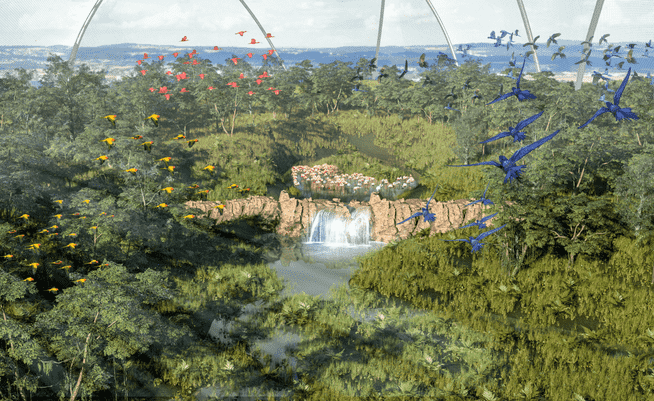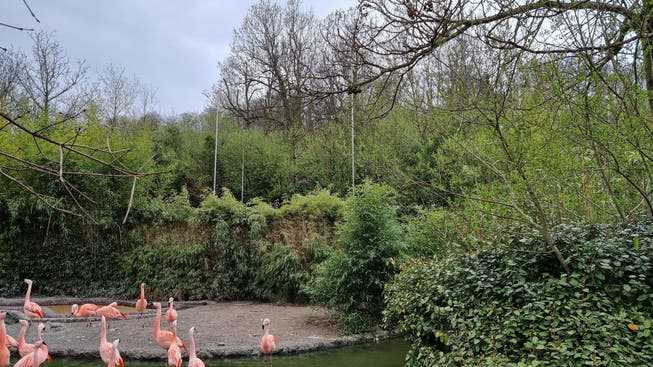For the time being, the zoo is refraining from building the Pantanal aviary that was actually approved. Residents have resisted – and have their suspicions.
After the aviary for lorikeets (pictured), another, much larger one is now being planned. This does not go down well with some residents of the zoo.
One day, Chilean flamingos, black-necked swans and hyacinth macaws will be able to fly at high altitudes in Zurich Zoo. In the 35 meter high aviary called Pantanal, lowland tapirs, squirrel monkeys and large anteaters will also romp about in the trees and on the ground. The zoo received the green light from its shareholder, the city of Zurich, for the construction of the 11,000 square meter free-flight cage last July – without being unplugged.
The publication of the construction project in the “Tagblatt der Stadt Zürich” or in the official gazette of the canton had not caught the eye of anyone in the immediate vicinity of the zoo, which is why the initiators only found out about the major project in September, at an information event organized by the zoo.
However, the invited neighbors were not informed that the building permit for the free-flight aviary had already been granted. “The zoo has never actively communicated the status of the building permits for its projects,” says its director, Severin Dressen. This is because there was simply no interest in it or it had never been asked.
It was only at the beginning of December 2021 that individual zoo residents became aware of the mammoth project through another publicly published planning application. This time it was about plans for changes to the approved free-flight aviary and the construction of four new animal houses that are necessary for the operation of the aviary. As a result, two zoo initiators filed a lawsuit with the construction appeals court.

The new zoo aviary should look like this visualization.
The disgruntled zoo neighbors took the legal route because such behavior “is not compatible with the usual understanding of the law”. They felt “presented and ripped off”. This is also because they had personally taken part in various participation events organized by the city of Zurich on the zoo’s planned traffic concept.
At no time during this process was it mentioned that the aviary project, another public attraction at the zoo, had already been submitted for approval and had even been “quietly and secretly” approved in the course of the participation. In addition, the legally required unplugging for the Pantanal cage did not take place.
Project «not representable»
Why wasn’t the planned free-flight aviary marked with poles? The project was “unrepresentable”, says Anja Grüter, Deputy Head of Communications at the City of Zurich’s Building Department. In the case of construction projects that cannot be represented, a stake out can be dispensed with. It was also difficult to set up a construction team in the monkey enclosure without giving the animals a chance to escape, the spokeswoman said.
The applicants from district 7 accuse the city, as a shareholder and member of the board of directors of Zoo Zurich AG, of not correctly and impartially fulfilling its duty to monitor. The city currently owns a 9.7 percent stake in the zoo. It also supports the zoo with 3.34 million francs annually. The city is therefore likely to have a major interest in the growth and international appeal of “their” zoo, the respondents speculate.
What does the Building Department say about the accusation of preferential treatment? As a shareholder, the city of Zurich has no direct supervisory obligation towards Zoo Zurich AG, spokeswoman Grüter explains. The building application, like any other, was checked by the Office for Building Permits and various specialist departments. “This examination showed that the building project complies with public law regulations, whereupon the building section of the city council issued the building permit.”
No restrictions on traffic
Sauer is particularly annoyed by the fact that Zurich Zoo has not been subject to any restrictions on traffic in connection with the Pantanal aviary. This is despite the fact that many residents have long suffered from the “immense volume of traffic” and cars parked haphazardly around the zoo. As early as May 2018, a postulate from the municipal council called on the city council to develop a new traffic concept for the zoo.
According to Anja Grüter, the Pantanal aviary is part of a legally valid design plan. This stipulates that a traffic concept will be developed in which the zoo has to participate. This traffic concept had been developed over the last two years and should soon be approved by the city council. In this context, it must be mentioned that the long-planned cable car to the zoo is still stuck in the legal process.
The residents’ appeal suddenly had unexpected consequences the week before last. Before the case was dealt with in the court of appeal of the canton of Zurich in the first instance, the zoo voluntarily gave up. In an information letter dated March 22nd, the neighbors of the zoo were informed that “we have been thankfully informed that too few details are known about the Pantanal construction project”. Zurich Zoo therefore decided to launch a new building application.
When the NZZ then sent the zoo a questionnaire on the allegations, it went on a communication offensive: In a media release on April 1, the zoo announced that zoo visitors would now find building profiles for the large aviary project. In addition, there is also a construction information board with an overall visualization in the area of the main entrance. In fact, the project is now partially staked out with construction profiles.

Building profiles in the area of today’s flamingo facility at Zurich Zoo.
Why did the zoo director Severin Dressen pull the rip cord and waive the building permit that he had already received? “Because of the ability to plan ahead,” he explains. Since the zoo may have wanted to prevent long-term procedures to clarify this “formality”, it decided to withdraw the previous procedures and put the entire project out to tender again.
However, the action appears to the residents as a “capitulation of the zoo across the board”. They suspect that such a powerful institution only does something like this if the risk of defeat in court is high.
The two appeal parties do not rule out a new lawsuit against “Pantanal 2.0”. In particular, all laws and regulations would have to be observed next time. In addition, the zoo promoters are demanding legally binding conditions for access and traffic. Without appropriate regulations to protect residents and the district from emissions, a new building permit for another, internationally recognized public attraction cannot be justified, they believe.
